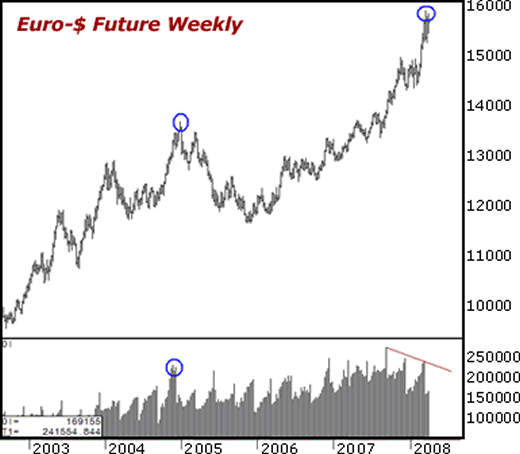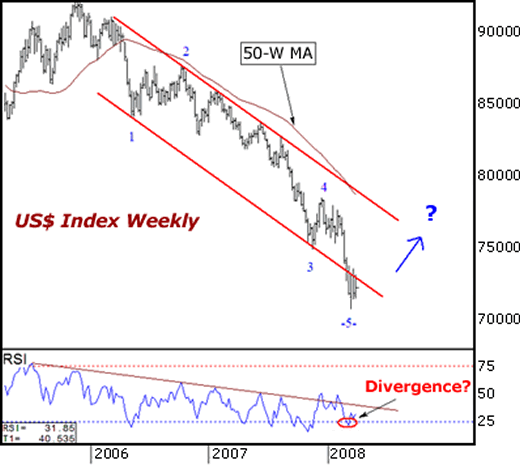Has the US Dollar Bottomed?
Currencies / US Dollar Apr 09, 2008 - 02:06 AM GMT  Jack Crooks writes: "A bottom in the dollar? Are you kidding me?" are just two of the incredulous questions you might be asking after reading this title. All snickering aside, I do think it's time to start considering something as outlandish as that.
Jack Crooks writes: "A bottom in the dollar? Are you kidding me?" are just two of the incredulous questions you might be asking after reading this title. All snickering aside, I do think it's time to start considering something as outlandish as that.
Despite still strong evidence to the contrary, there is compelling logic to suggest that, yes, the buck has bottomed. And if that is in fact the case, a sustained rally in the greenback would certainly present a rather lucrative proposition. Today, we'll delve into that very scenario.
But first, let's play devil's advocate and look at three bearish reasons why the dollar could continue to slide lower ...
Bearish Reason #1: The global hunt for yield.
Interest rates are consistently one of the most powerful drivers in the currency market. Because currency trading is a relative game, i.e. comparing one currency against another, the interest rate differential is always a consideration. As a rule: the higher the rate of interest (real rate of interest that is, measured as the nominal yield minus the inflation rate) the more attractive the currency.
| Country | Real Yield | 3-mo Yield | Inflation |
| Australia | 4.8 |
7.76 |
3.0 |
| UK | 3.5 |
6.01 |
2.5 |
| Euro | 1.4 |
4.72 |
3.3 |
| Switzerland | 0.5 |
2.85 |
2.4 |
| Japan | 0.1 |
0.75 |
0.7 |
| Canada | 0.1 |
1.85 |
1.8 |
| U.S. | -1.7 |
2.26 |
4.0 |
Of course there's a solid reason this dynamic exists. Let's call it The Global Hunt for Yield . Think of it as massive pools, or waves of capital, ebbing and flowing across the global landscape in search of the highest total return. Often this money is referred to as hot money. And though this is considered short-term capital, with a time horizon in months to a couple of years, these waves can have a significant impact on currency prices.
Currently, interest rates are a net negative for the U.S. dollar. And the expectations of even more cuts by the Federal Reserve in order to stave off, or at least moderate, recession means the dollar will continue to lose out on the hot money wave of capital.
Below is a list of real yield (nominal rate minus inflation rate) for the seven major currencies. Notice the U.S. is pulling up the rear with a negative real yield of 1.7%:
The logic here is the dollar continues to fall until either the Fed hikes rates or the other central banks begin cutting rates.
Bearish Reason #2: There's been no panic spike yet.
Often we see the U.S. dollar spike down when a bear market is ending, or spike up when a bull market is ending. This spike (often coinciding with overbought or oversold levels) can be measured by the number of standard deviations from the mean.
Based on research done by Credit Suisse, utilizing a six-month time frame to derive the mean trend and comparing the dollar against the euro to derive the degree of overbought or oversold, here is a look at the evidence suggesting the dollar is still not oversold enough yet.
$ - Euro: # of std. deviations away from 6-month MA |
||
| Start of a dollar bear market | Mar-85 | 2.3 standard overbought |
| Start of a dollar bull market | Aug-92 | 2.4 standard oversold |
| Current dollar bull market | Now | 1.5 standard oversold |
Bearish Reason #3: Not enough dollar cynics.
Okay, maybe there are more than enough dollar cynics out there, but actions speak louder than words. In the investment world there is often a big difference between what someone says and what someone does. Both can play a powerful role.
Talking can impact sentiment, which can impact or lead to changes in trend. But typically, we see both talking and acting bears joining forces near the end of a major dollar bear market. That's when everyone hates the dollar and tells you so. And everyone is short the dollar and the open interest levels in the currency futures markets tell you so.
No doubt the positioning against the dollar is quite bearish (using the currency futures open interest as a guide). But it doesn't quite qualify as being at extreme levels for the major trend.
Below is a chart of the euro currency future. At the bottom of the chart I have listed the open interest levels. As you can see in the chart, recent highs in the euro have not coincided with an extreme in open interest. Back in late 2004 we had an extreme open interest reading as the euro made a new high. That preceded an 11-month bear market in the euro (which coincided with a dollar bull market). Using this indicator alone, it suggests there is now more room for the euro to rise and the dollar to fall:

Now, for the moment you've patiently been waiting for! Let's talk about three bullish catalysts which could spur a rally after the dollar puts in a bottom ...
Bullish Catalyst #1: Recession.
Fed Chairman Bernanke recently admitted the U.S. is either in or will enter recession. So what? You're probably surprised to see recession listed as a reason why the dollar may have bottomed. It does seem a bit counterintuitive, but that's the nature of currency trading; history is on the side of the dollar during recession. History shows, more often than not, that the dollar actually rallies during recessions.
According to research by Adam Cole, RBC Capital Markets Head, and recently published in FX Week magazine:
" Four of the last five recessions have been associated with USD appreciation. On average, the DXY dollar index has risen 3.4% during recessionary periods compared with an average fall of 1.2% over the whole 35-year period of floating exchange rates ."
Here are the logical reasons for the buck to rally during recession, as Mr. Cole cited. I have taken the liberty of adding my own commentary after each of Mr. Cole's main points (which I've underlined):
A.) Markets are forward looking . In short, this means all the bad news is already anticipated, and therefore priced in. Participants expect things to get better in the future and act accordingly, i.e. they believe the dollar has bottomed.
B.) During downturns, markets reward central banks that are flexible and punish central banks that are slow to ease policy . Well, this is interesting and flies in the face of the argument that says the dollar can only rally once the Fed starts hiking or the European Central Bank starts cutting. Flexible monetary policy and real action are rewarded. Does the latest Fed action fit this criterion?
C.) U.S. retains some residual status as a safe haven . Despite ugly rumors to the contrary, the U.S. capital markets are still the deepest and most efficient in the world. It is why, despite the dollar bear market, America is still the place to park big pools of money in a world full of risk.
Now, let's talk about euro and the pound ...
Bullish Catalyst #2: Toil and trouble brewing across the Atlantic.
As I've said before, currency analysis is akin to being the judge at an ugly contest. Your job as the judge is to select the least ugly as the winner. And interestingly, the euro and British pound are growing increasingly ugly relative to the dollar.
The key drivers of ugliness for both currencies is similar: exposure to credit market problems just like the U.S., falling retail sales, housing markets heading into bust stage. And for the euro in particular, some countries face severe fiscal problems. All in all it's beginning to hammer growth in both the U.K. and across the Eurozone.
I believe pressure is building for both the European Central Bank and Bank of England to start cutting rates aggressively. (This dovetails with the point I made above regarding the market punishing those central banks slow to ease policy.)
If so, the yield differential between both currencies and the dollar would decline, and if players in the market perceived the Fed is done and the next move in rates is up, the sentiment for the buck could change quickly.
As odd as it may seem, I can actually envision the U.S. coming out of its malaise just as both the U.K. and Eurozone become more deeply ensconced. Stranger things have happened.
Bullish Catalyst #3: The technical picture.
The buck appears extremely oversold on a daily and weekly basis. Below is a chart of the U.S. dollar index on a weekly basis. Here are the key points to consider based on the chart:
- The recent low would coincide with a major wave down, indicating the next move is up (labeled as -5-).
- And there has been a major divergence in the price oscillators, i.e. the dollar put in a new all-time low, yet the relative strength index failed to make a new low (notice the divergence circled in red at the bottom of the chart). Often times, price action like that precedes a significant change of trend.
- For the first time since November 2005, the dollar index has pierced its downtrend channel, suggesting an extreme oversold reading (see the red parallel lines on this chart).

So where does the dollar tread from here?
As you can see, there are strong reasons on both sides of the argument as to whether or not the buck has bottomed. If push comes to shove, I would say this: I believe there is a high probability for a correction in the dollar, or decent rally higher. And from a risk-reward standpoint, it may make sense to play for a bounce.
Bottom Line: You and I have witnessed plenty of false break-outs before. So even if there is a rally, we will still need more evidence before we can conclusively say the bottom is in on the buck!
Stay tuned; I believe that if we haven't seen a reversal in the dollar already, we're not very far away.
Best wishes,
Jack
This investment news is brought to you by Money and Markets . Money and Markets is a free daily investment newsletter from Martin D. Weiss and Weiss Research analysts offering the latest investing news and financial insights for the stock market, including tips and advice on investing in gold, energy and oil. Dr. Weiss is a leader in the fields of investing, interest rates, financial safety and economic forecasting. To view archives or subscribe, visit http://www.moneyandmarkets.com .
Money and Markets Archive |
© 2005-2022 http://www.MarketOracle.co.uk - The Market Oracle is a FREE Daily Financial Markets Analysis & Forecasting online publication.



